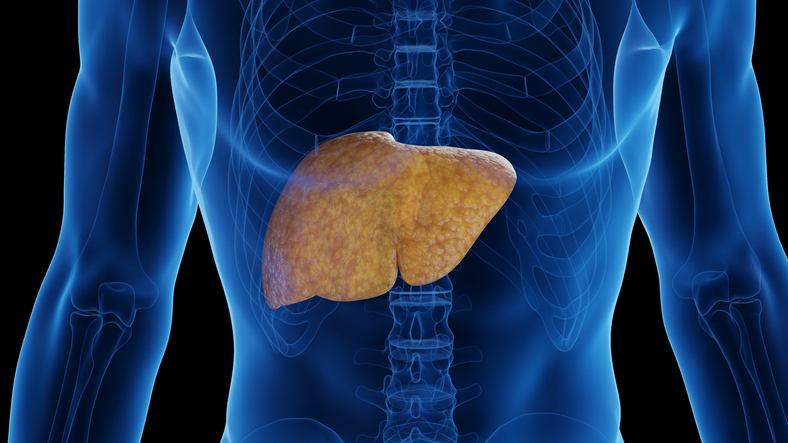
An Akero Therapeutics drug in development for the fatty liver disease MASH now has clinical trial results showing the experimental treatment reversed organ scarring, bringing patients back from an advanced stage of this disorder that can lead to liver failure.
In metabolic dysfunction-associated steatohepatitis, or MASH, inflammation and fibrosis (liver scarring) damages the organ. The preliminary results announced Monday are from a Phase 2 study that enrolled 182 adults whose MASH had led to compensated cirrhosis, meaning the liver is still functioning but is severely damaged. When fibrosis advances to this point, stage 4, the risk of liver failure is high and an organ transplant is the only remaining treatment option.
The Phase 2 test of the Akero drug, efruxifermin (EFX), was designed with a main goal of showing improvement by one stage of fibrosis or more with no worsening of other measures of MASH after 96 weeks of treatment. The South San Francisco-based biotech said 39% of patients who received the 50 mg dose, the higher of the two doses tested, achieved this goal. By comparison, 15% of patients who received a placebo met the trial goal. These results were statistically significant.

Integrating GLP-1s: How Berry Street is Redefining Nutrition Care
Richard Fu details the company's approach to nutrition therapy and strategy for patients using GLP-1s.
The results at 96 weeks redeem an earlier trial failure for EFX. In 2023, Akero reported data from the study showing statistical significance on multiple measures of MASH, but not on the main goal of assessing fibrosis at 36 weeks. The disappointing result sank Akero shares. Nevertheless, the clinical trial was designed to continue for 96 weeks and Akero said it believed the drug had potential to show additional improvement with longer duration of treatment. The company decided to continue the study, a bet that has paid off.
MASH has been an elusive disease target for drug developers, but the field has made progress. Last year, Madrigal Pharmaceuticals’ Rezdiffra became the first FDA-approved treatment for MASH. The drug, a small molecule formulated as a once-daily pill, is approved for use in patients with moderate-to-advanced liver scarring, which is stage 2 or 3 fibrosis. It is not indicated for patients with stage 4 disease.
EFX is a fusion protein engineered to mimic FGF21, a protein native to the body that regulates energy expenditure and the metabolization of fats. Akero has designed its subcutaneously injected drug for once-weekly dosing. Speaking during a conference call Monday, Akero Chief Development Officer Kitty Yale noted an unmet medical need remains for MASH patients with more advanced disease.
“Over the past decade, no compound has been shown to statistically significantly reverse cirrhosis,” she said. “We are excited about EFX potential to be the first treatment option for patients with compensated cirrhosis due do MASH, pending Phase 3 trial results and if approved by regulatory agencies.”

How Zelis is Transforming Healthcare Payments with Enterprise AI
How Zelis hopes to solve the healthcare financial system for payers and providers.
Yale said 87% of patients for whom liver biopsies were collected at week 36 remained in the study to week 96. Of those who did not show a response to the study drug at week 36, 26% of those in the 50 mg group were responders at week 96, three times greater than placebo. Adverse effects reported in the study include diarrhea, nausea, and increased appetite. Yale said trial investigators determined that no serious adverse events were treatment related.
One potential risk of the FGF21 analog drug class is bone loss. The EFX Phase 2 results show a 2-3% per year placebo-adjusted reduction in spine and hip bone mineral density. For context, use of GLP-1 drugs for diabetes has been recently reported to be associated with about a 2% reduction in bone mineral density after one year, Yale said.
Three Phase 3 studies are already underway evaluating the 50 mg dose of EFX in MASH. One trial is evaluating patients with stage 2 or 3 fibrosis. Another study is testing EFX in patients with compensated cirrhosis due to MASH. The third clinical trial is a real-world study in patients with either MASH or metabolic dysfunction associated steatotic liver disease. Akero CEO Andrew Cheng said the takeaway from the Phase 2 trial is that longer dosing matters given the substantial cirrhotic burden of the disease.
“I don’t think we’ve seen our maximal response,” he said. “We’ve just seen the two-year response, keeping in mind that our Phase 3 SYNCHRONY outcome study is an event-driven study and may go on anywhere from three to five years. So I think over time, we’ll continue to see the benefit of substantial efficacy.”
The 96-week data from EFX’s Phase 2 study exceed expectations in the difficult to treat stage 4 fibrosis population, Leerink Partners analyst Thomas Smith wrote in a note sent to investors. He added that the encouraging outcomes from non-invasive tests with no immediate new safety concerns are positive for the FGF21 drug class and have positive readthrough to 89bio, de-risking that company’s FGF21 drug, pegozafermin.
Image: Sebastian Kaulitzki/Science Photo Library, via Getty Images






